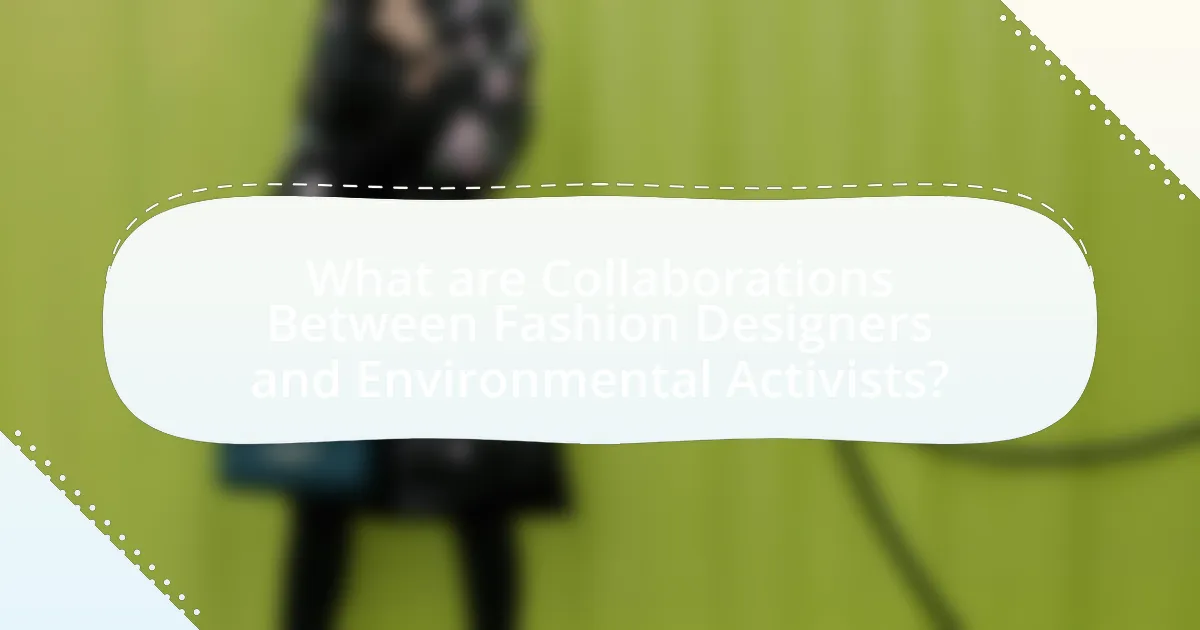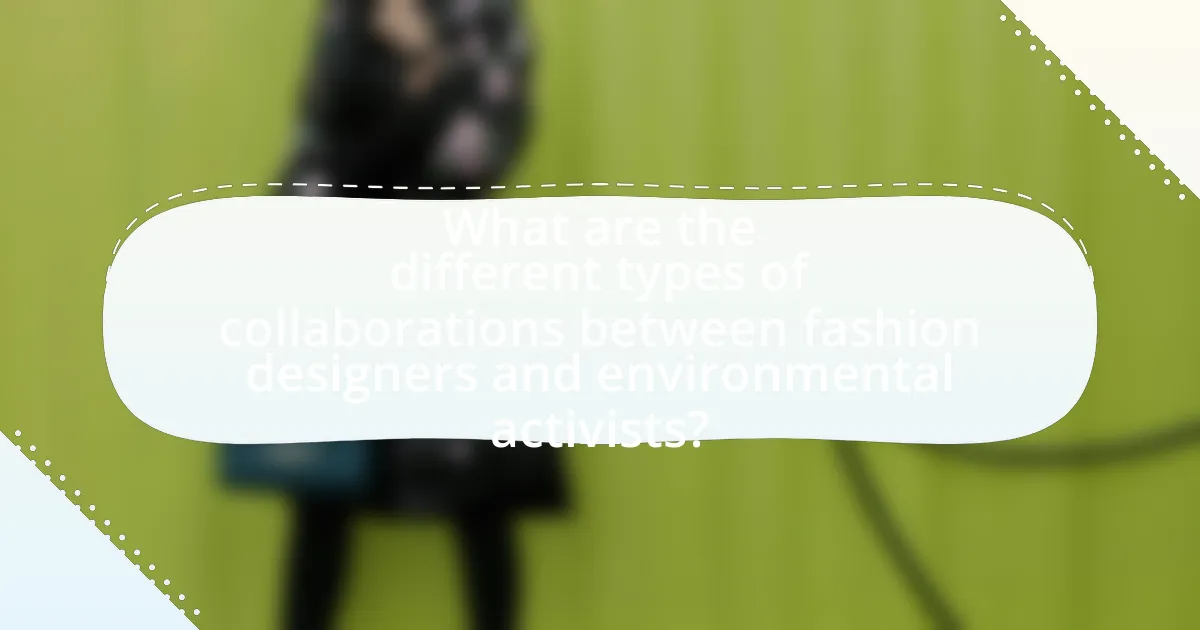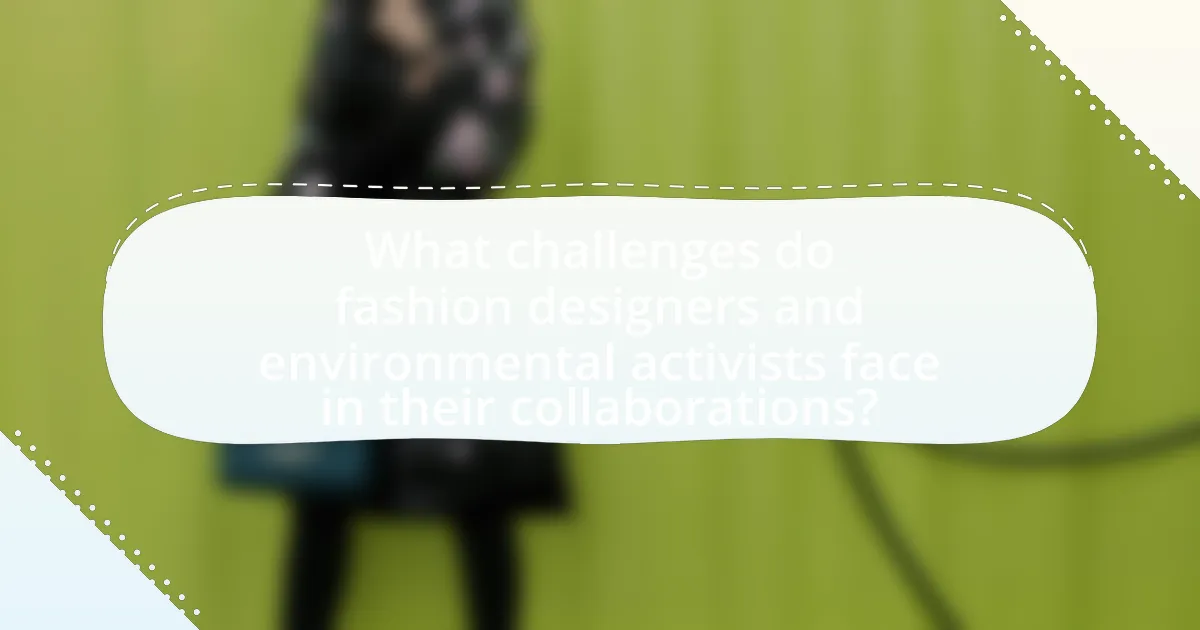Collaborations between fashion designers and environmental activists focus on promoting sustainable practices within the fashion industry. These partnerships lead to the development of eco-friendly clothing lines, awareness campaigns, and initiatives advocating for ethical production methods. Key goals for designers include integrating sustainability into their collections, while activists aim to influence industry standards and consumer behavior. The article explores the impact of these collaborations on the fashion industry, the challenges faced, and successful examples of co-designed sustainable fashion lines, highlighting the importance of sustainability in today’s market. Additionally, it discusses the financial implications and best practices that enhance these partnerships.

What are Collaborations Between Fashion Designers and Environmental Activists?
Collaborations between fashion designers and environmental activists involve partnerships aimed at promoting sustainable practices within the fashion industry. These collaborations often result in the creation of eco-friendly clothing lines, awareness campaigns, and initiatives that advocate for ethical production methods. For instance, the partnership between Stella McCartney and various environmental organizations has led to the use of sustainable materials and a commitment to reducing waste in fashion. Such collaborations not only highlight the importance of environmental responsibility but also influence consumer behavior towards more sustainable choices in fashion.
How do these collaborations impact the fashion industry?
Collaborations between fashion designers and environmental activists significantly impact the fashion industry by promoting sustainable practices and raising awareness about environmental issues. These partnerships often lead to the creation of eco-friendly collections that utilize sustainable materials and ethical production methods, thereby reducing the industry’s carbon footprint. For instance, the collaboration between Stella McCartney and various environmental organizations has resulted in innovative designs that prioritize animal welfare and sustainable sourcing, influencing other brands to adopt similar practices. Additionally, such collaborations help educate consumers about the importance of sustainability, driving demand for environmentally conscious fashion and encouraging a shift towards more responsible consumption patterns.
What are the key goals of fashion designers in these collaborations?
The key goals of fashion designers in collaborations with environmental activists include promoting sustainability, raising awareness about environmental issues, and innovating eco-friendly materials and practices. By partnering with activists, designers aim to integrate sustainable practices into their collections, thereby reducing the fashion industry’s environmental impact. For instance, collaborations often focus on creating garments from recycled materials or organic fabrics, which directly addresses the growing demand for sustainable fashion. Additionally, these partnerships help to educate consumers about the importance of environmental responsibility in fashion, leveraging the influence of both designers and activists to drive change in consumer behavior and industry standards.
What are the primary objectives of environmental activists in these partnerships?
The primary objectives of environmental activists in partnerships with fashion designers are to promote sustainable practices and reduce the environmental impact of the fashion industry. These activists aim to influence designers to adopt eco-friendly materials, implement ethical production processes, and raise awareness about the environmental consequences of fast fashion. For instance, organizations like Greenpeace have successfully campaigned for brands to eliminate hazardous chemicals from their supply chains, demonstrating the effectiveness of such partnerships in driving industry change.
Why are these collaborations becoming increasingly important?
Collaborations between fashion designers and environmental activists are becoming increasingly important due to the urgent need for sustainable practices in the fashion industry. The fashion sector is one of the largest polluters globally, contributing to significant environmental degradation, which has prompted a shift towards eco-friendly initiatives. For instance, a report by the Ellen MacArthur Foundation highlights that the fashion industry is responsible for 10% of global carbon emissions and is a major contributor to water pollution. By partnering with environmental activists, designers can leverage innovative sustainable materials and practices, thereby reducing their ecological footprint and promoting awareness about environmental issues. This synergy not only enhances brand reputation but also aligns with consumer demand for ethical and sustainable products, as evidenced by a 2021 McKinsey report indicating that 67% of consumers consider sustainability when making purchasing decisions.
How do consumer preferences influence these partnerships?
Consumer preferences significantly influence partnerships between fashion designers and environmental activists by driving the demand for sustainable practices and eco-friendly products. As consumers increasingly prioritize sustainability, designers are compelled to align their practices with these preferences to remain competitive and relevant in the market. For instance, a 2021 survey by McKinsey & Company found that 67% of consumers consider sustainability when making a purchase, prompting brands to collaborate with environmental activists to enhance their credibility and appeal. This alignment not only helps in attracting a conscious consumer base but also fosters innovation in sustainable fashion, as designers seek to incorporate eco-friendly materials and practices advocated by activists.
What role does sustainability play in the fashion industry today?
Sustainability plays a critical role in the fashion industry today by driving the adoption of eco-friendly practices and materials. Fashion brands increasingly prioritize sustainable sourcing, reducing waste, and minimizing carbon footprints to meet consumer demand for ethical products. For instance, a 2021 McKinsey report highlighted that 67% of consumers consider sustainability when making purchasing decisions, prompting brands to collaborate with environmental activists to enhance their sustainability efforts. These collaborations often lead to innovative solutions, such as the use of recycled materials and sustainable production methods, further solidifying sustainability as a key focus in the industry.

What are the different types of collaborations between fashion designers and environmental activists?
Fashion designers and environmental activists engage in various types of collaborations, primarily focusing on sustainable practices, awareness campaigns, and innovative materials. These collaborations often include co-designing eco-friendly clothing lines that utilize organic or recycled materials, thereby reducing environmental impact. Additionally, designers may partner with activists to create awareness campaigns that highlight the importance of sustainable fashion, leveraging social media and public events to reach a broader audience. Furthermore, some collaborations involve educational initiatives, where designers and activists work together to inform consumers about the environmental consequences of fast fashion and promote responsible consumption. These partnerships are increasingly recognized for their potential to drive change within the fashion industry and encourage more sustainable practices among consumers.
How do fashion designers and activists collaborate on product development?
Fashion designers and activists collaborate on product development by integrating sustainable practices and ethical considerations into the design process. This collaboration often involves designers working closely with activists to understand the environmental and social impacts of materials and production methods. For instance, initiatives like the Fashion Revolution movement encourage transparency in supply chains, prompting designers to adopt eco-friendly materials and fair labor practices. Research from the Ellen MacArthur Foundation highlights that such collaborations can lead to innovative solutions, like upcycled fabrics and zero-waste designs, which not only reduce environmental impact but also resonate with socially conscious consumers.
What are some successful examples of co-designed sustainable fashion lines?
Successful examples of co-designed sustainable fashion lines include the collaboration between Stella McCartney and the environmental organization Parley for the Oceans, which focuses on creating garments from recycled ocean plastics. Another notable example is the partnership between H&M and the non-profit organization WWF, which aims to promote sustainable materials and practices in fashion. Additionally, the collaboration between Adidas and Parley for the Oceans has resulted in a line of shoes made from ocean plastic waste, demonstrating a commitment to sustainability in the fashion industry. These collaborations highlight the effective merging of fashion design with environmental activism, leading to innovative and eco-friendly products.
How do these collaborations address waste reduction in fashion?
Collaborations between fashion designers and environmental activists address waste reduction in fashion by promoting sustainable practices and innovative recycling methods. These partnerships often result in the development of eco-friendly materials and the implementation of circular fashion principles, which aim to minimize waste by reusing and recycling textiles. For instance, initiatives like the Ellen MacArthur Foundation’s “Make Fashion Circular” encourage brands to design products with end-of-life considerations, significantly reducing landfill contributions. Additionally, collaborations frequently lead to educational campaigns that raise awareness about the environmental impact of fashion waste, further driving consumer demand for sustainable options.
What initiatives are commonly undertaken in these collaborations?
Collaborations between fashion designers and environmental activists commonly undertake initiatives focused on sustainable fashion practices. These initiatives include the development of eco-friendly materials, promotion of circular fashion concepts, and implementation of ethical production processes. For instance, many designers partner with activists to create collections that utilize organic or recycled fabrics, reducing the environmental impact of textile production. Additionally, campaigns aimed at raising awareness about the environmental consequences of fast fashion are frequently launched, encouraging consumers to make more sustainable choices. These efforts are supported by research indicating that sustainable practices can significantly reduce carbon footprints and waste in the fashion industry.
How do awareness campaigns contribute to the goals of these partnerships?
Awareness campaigns significantly enhance the goals of partnerships between fashion designers and environmental activists by educating the public on sustainable practices and promoting eco-friendly fashion choices. These campaigns raise visibility for environmental issues, leading to increased consumer demand for sustainable products, which aligns with the objectives of both designers and activists to foster a more responsible fashion industry. For instance, a study by the Fashion Institute of Technology found that 70% of consumers are more likely to purchase from brands that demonstrate a commitment to sustainability, illustrating the direct impact of awareness campaigns on consumer behavior and partnership goals.
What educational programs are developed through these collaborations?
Collaborations between fashion designers and environmental activists develop educational programs focused on sustainable fashion practices. These programs often include workshops, online courses, and community outreach initiatives that teach participants about eco-friendly materials, ethical production methods, and the impact of fashion on the environment. For example, initiatives like the Fashion for Good program provide resources and training to promote circular fashion and reduce waste, demonstrating the effectiveness of these collaborations in fostering awareness and knowledge in sustainable practices.

What challenges do fashion designers and environmental activists face in their collaborations?
Fashion designers and environmental activists face significant challenges in their collaborations, primarily due to differing priorities and approaches. Designers often prioritize aesthetics and marketability, while activists focus on sustainability and ethical practices. This divergence can lead to conflicts in decision-making, as designers may resist changes that compromise their creative vision, whereas activists may push for stricter environmental standards. Additionally, the fashion industry’s fast-paced nature can clash with the slower, more deliberate processes favored by environmentalists, making it difficult to align timelines and goals. These challenges are compounded by the need for transparency and accountability, as both parties must navigate complex supply chains and ensure that their collaboration genuinely reflects sustainable practices rather than superficial greenwashing.
How do differing priorities affect collaboration outcomes?
Differing priorities significantly hinder collaboration outcomes between fashion designers and environmental activists. When fashion designers prioritize profit and market trends, while environmental activists focus on sustainability and ecological impact, misalignment occurs, leading to ineffective partnerships. For instance, a study published in the Journal of Business Ethics highlights that conflicting objectives can result in communication breakdowns and reduced trust, ultimately diminishing the effectiveness of collaborative efforts. This misalignment can cause delays in project timelines and failure to achieve shared goals, as seen in various case studies where initiatives aimed at sustainable fashion fell short due to prioritization discrepancies.
What are the common conflicts between fashion aesthetics and environmental goals?
Common conflicts between fashion aesthetics and environmental goals include the use of non-biodegradable materials and the fast fashion model, which prioritizes rapid production and consumption over sustainability. For instance, synthetic fabrics like polyester, often favored for their aesthetic appeal, contribute to microplastic pollution and are derived from fossil fuels, undermining environmental objectives. Additionally, the fast fashion industry, which emphasizes trendy, low-cost clothing, leads to excessive waste and resource depletion, as it encourages consumers to discard garments quickly. According to the Ellen MacArthur Foundation, the fashion industry is responsible for 10% of global carbon emissions, highlighting the tension between aesthetic desires and ecological responsibility.
How can these challenges be overcome for successful partnerships?
Successful partnerships between fashion designers and environmental activists can be achieved by establishing clear communication and shared goals. Effective communication ensures that both parties understand each other’s values and objectives, which is crucial for aligning their efforts. Research indicates that partnerships with defined roles and responsibilities lead to higher success rates, as seen in the collaboration between Stella McCartney and environmental organizations, which focused on sustainable practices and transparency. Additionally, fostering mutual respect and trust can enhance collaboration, as evidenced by initiatives that prioritize stakeholder engagement and feedback, ultimately leading to innovative solutions that benefit both the fashion industry and environmental sustainability.
What are the financial implications of these collaborations?
Collaborations between fashion designers and environmental activists can lead to significant financial implications, including increased brand value and consumer loyalty. These partnerships often result in the development of sustainable products, which can attract a growing market segment that prioritizes eco-friendly practices. For instance, a study by McKinsey & Company in 2021 indicated that 67% of consumers consider sustainability when making purchasing decisions, suggesting that brands engaging in such collaborations may experience higher sales and market share. Additionally, these collaborations can reduce costs associated with waste and resource inefficiency, as seen in brands that adopt circular economy principles. Overall, the financial benefits stem from enhanced brand reputation, access to new customer bases, and potential cost savings through sustainable practices.
How do funding and sponsorship affect the success of these initiatives?
Funding and sponsorship significantly enhance the success of collaborations between fashion designers and environmental activists by providing essential financial resources and visibility. These financial contributions enable initiatives to access advanced materials, sustainable technologies, and marketing efforts that would otherwise be unattainable. For instance, a study by the Fashion Institute of Technology found that projects with substantial sponsorship saw a 40% increase in outreach effectiveness and engagement levels compared to those without funding. This financial backing not only facilitates the execution of innovative ideas but also attracts additional partnerships and media attention, further amplifying the impact of the initiatives.
What are the economic benefits for designers and activists involved?
Designers and activists involved in collaborations can experience significant economic benefits, including increased market reach and enhanced brand value. By partnering, designers tap into the growing consumer demand for sustainable and ethically produced fashion, which can lead to higher sales and customer loyalty. Activists gain financial support for their initiatives through these collaborations, as brands often allocate a portion of profits to environmental causes. For instance, a study by McKinsey & Company highlights that brands focusing on sustainability can see a 10-15% increase in sales, demonstrating the financial advantages of aligning with environmental values.
What best practices can enhance collaborations between fashion designers and environmental activists?
Best practices that can enhance collaborations between fashion designers and environmental activists include establishing clear communication channels, aligning goals, and engaging in joint projects. Clear communication ensures that both parties understand each other’s perspectives and objectives, which is crucial for effective collaboration. Aligning goals allows fashion designers to incorporate sustainable practices that resonate with environmental activists’ missions, fostering a shared vision. Engaging in joint projects, such as sustainable fashion shows or eco-friendly product lines, can create tangible outcomes that demonstrate the benefits of their partnership. These practices are supported by successful collaborations, such as the partnership between Stella McCartney and environmental organizations, which has led to innovative sustainable fashion initiatives.

Leave a Reply